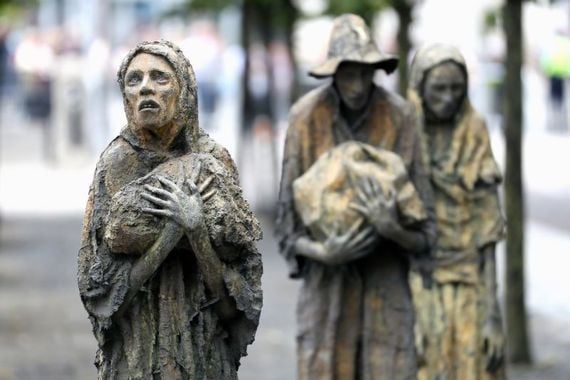The National Famine Way Commemorative Walk, which takes place over six days and traverses six counties, is set to begin on Monday.
The six-day walk will begin at the National Famine Museum in Strokestown, County Roscommon, on Monday, May 20, and finish at EPIC The Irish Emigration Museum in Dublin’s Docklands at 4 p.m. on Saturday, May 25.
The walk, which spans 165km, begins with a dramatic re-enactment of the events in 1847 which prompted the foundation of the trail including traditional musicians, school children, and walkers dressed in famine costume.
Members of the Tighe family, whose ancestors were evicted during the Famine, will read out the names of all 1,490 tenants who were forced to leave their homes in Strokestown and emigrate to Canada aboard coffin ships during the Famine.
The route passes through Counties Roscommon, Longford, Westmeath, Meath, Kildare, and Dublin and concludes with the launch of the Global Irish Famine Way on Saturday at EPIC.
The Global Irish Famine Way is an extension of the National Famine Way and will be the largest heritage trail in the world once completed. It will eventually follow the journeys of all the Irish Famine emigrants around the world, including the UK, Canada, the United States, South Africa, and Australia.
The bronze shoes that mark the National Famine Way in Ireland will also mark sites along the global route, with shoes set to be installed at sites in Liverpool and Canada throughout 2024.
A total of 15 sites have already been secured in Canada, including Grosse Île, St John’s Newfoundland, Quebec City, Montreal, Ottawa, and Toronto. In memory of the original journey undertaken by emigrants during the Famine, the bronze shoes have traveled from Galway to Newfoundland on the Marine Institute vessel the RV Celtic Explorer, with a series of commemorative events planned to mark their arrival.
Meanwhile, the first set of bronze shoes set to be installed in Liverpool will be carried along the National Famine Way Commemorative Walk by representatives from Liverpool. The shoes are set to be taken by ferry to Holyhead before being taken by road to Birkenhead and by ferry again to Mersey Ports.
From there, a group of Liverpool representatives will walk the shoes to Clarence Docks, where 1.3 million Irish emigrants were brought to during the Great Hunger.
Irish Ambassador to Canada Eamonn McKee and representatives from the Liverpool Irish Famine Trail will also lead the commemorative Famine walk on Monday.
Caroilín Callery of the National Famine Way said the commemorative walk would be the first such walk since the trail was launched in 2019 and noted the importance of honoring the international voyages undertaken by migrants during the Famine.
"Our emigrants did not stop in the Quays in Dublin." Callery said.
"Their journeys spread far and wide around the world and it is only fitting to tell the second part of their stories as they carved out new lives on foreign shores and had worldwide influence over the decades and centuries to follow which is still being felt worldwide today.
"And we can see and feel that in the huge interest and warm welcome the Bronze Shoes have received already in this inaugural phase."
Meanwhile, the annual National Famine Commemoration takes place in Edgeworthstown, County Longford, on Sunday, marking the first time that the yearly commemoration has taken place in Longford.
"Each year the National Famine Commemoration gives communities a chance to gather and pay their respects to the people of our nation who faced hardship and suffering during An Ghorta Mór," Minister for Culture Catherine Martin said in a statement.
"Edgeworthstown has a deep connection to the devastating impact of the Famine. The town was founded by the Edgeworth family, which included the renowned novelist Maria Edgeworth.
"The family was involved in many charitable efforts at the time to provide assistance to their locality. Maria Edgeworth in particular used her international influence to secure support for her community, using her final novel, “Orlandino”, to raise funds for the famine relief effort."




Comments